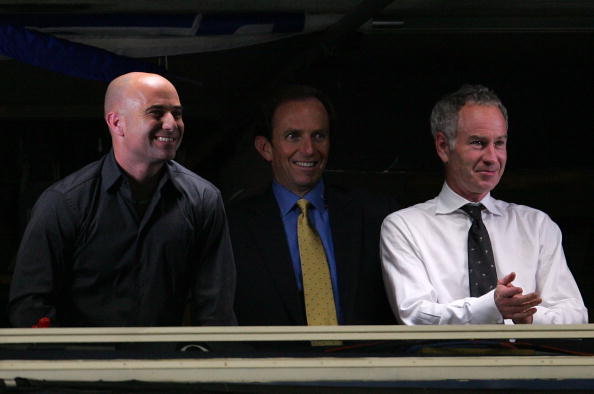BILL SIMONS
He nailed it. Then again, he often does.
When a young, long-haired kid with a dreamy game first emerged at Wimbledon, broadcaster Ted Robinson’s authoritative voice told us: Here, for sure, is a future dominant Grand Slam champ.
Robinson – an Atherton, California resident who in August will be inducted into the Northern California Tennis Hall of Fame – was right on about Roger Federer. Then again, with his easy brilliance, unruffled awareness and mind-boggling versatility, he’s gotten it right for almost four decades about a dizzying array of sports. Whether enlivening a Tennis Channel broadcast of a second-round match from Barcelona or Charleston, or bringing us football, hockey, baseball, hoops, volleyball, diving, kayaking, or even the most arcane of Olympic sports, Ted has done it all.
If there were a decathlon for sports broadcasters, TRob would get the gold. One imagines his business card says, “Have insights, will broadcast.”
There are two pillars to Robinson’s gentle genius. He understands that even if a sport is obscure, it’s everything to those who are watching. And he religiously stays in his lane. He explains, “We’ve all played sports and we all think we know. But the only person that tunes in to hear what I think about tennis is my mother. In most cases broadcasters have someone sitting next to them who has played the sport. Often I’ll have Martina, Chrissie, Lindsay, Jim Courier or Johnny Mac by me. What the hell do I know about tennis in comparison to them? So I stay out of it and let them talk tennis.”
Robinson likens himself to a setter in volleyball and then switches sports and calls himself the ultimate BP (batting practice) pitcher. “That’s exactly what my job should be. I’ve learned what conversation points to trigger and what questions to prompt.”
To some, Robinson’s taming of the irascible John McEnroe was all but a broadcasting miracle. Famously strong-willed and opinionated, McEnroe booted a beloved broadcaster out of NBC’s booth, and Mac didn’t exactly fancy taking cues from producers.
Enter Robinson, the McEnroe Whisperer, who brings calm, balance and an uncanny sense of rhythm to a broadcast. His respect of Johnny Mac is his secret sauce. He told us glowingly of McEnroe’s under-the-radar generosity, his loyalty to friends, his smarts and his unblinking confidence.
McEnroe’s broadcasts are, like his tennis, based on an un-coached, “I-just-gotta-be-free” spontaneity. While munching a turkey sandwich at a Birkenstocks-welcome Berkeley restaurant, Robinson told IT, “John’s really smart. What made us click was that neither of us likes scripts or rehearsals. I’ve always been a believer in sports being live. John always rebelled if someone tried to tell him how to talk. I’d say, ‘I’m going to ask you about something’ and he’d cut me off. John loves spontaneity.” And fans love Robinson.
It’s said that the greatest tennis broadcasting cluster is McEnroe, Robinson and the extraordinary Mary Carillo. Incredibly, the three of them are all from Queens, NY, are all southpaws and were born within 23 months of each other.
*****
Robinson is the Novak Djokovic of American sports broadcasting. His flexibility astounds. Ted was cooped up for seven hours in the tiny Wimbledon booth as he broadcast the greatest match of all time – the Nadal-Federer Wimbledon final in 2008. And he gave us a dandy broadcast of the relatively obscure Cal vs. Stanford match on the Pac 12 Network in April.
Robinson relishes provocative sports comparisons. To him, tennis is like boxing – mano a mano – without the violence. He detects fun links between tennis and baseball. For one, there’s the similarity between serving and pitching. “I didn’t understand that at first, but it’s ridiculous how similar the mindsets are. There are fastball pitchers like the John Isners and Randy Johnsons. But then there’s Greg Maddux, who’s Federer. He doesn’t overpower you with his serve, but he has the most insane pinpoint accuracy you could imagine.”
Ted talks of other intriguing baseball analogies: “If you’re up on your opponent love-40, but don’t break serve, that’s like a team loading the bases with nobody out and not scoring. It’s a crushing mental blow.”
Barely taking a breath, Robinson notes the similarities of two very different athletic geniuses – “The Baby-Faced Assassin” and “The Almighty Federer.” “What basketball’s Steph Curry is doing,” says TRob, “is making the unthinkable look sickeningly easy. That’s what Roger has done – winning for so many years, while barely breaking a sweat. He’s the quietest player I ever heard. He makes so little noise – his feet are so light, he doesn’t grunt, he barely breathes or speaks and never curses or exhorts himself. His backhand, balance and footwork are what separates him. You never see him off balance or lunging. Is that self-taught? Did he watch Baryshnikov, or other great tennis or soccer players?”
To Robinson, basketball is the easiest sport to broadcast. “The court is small, the players are big, the ball is big. You can’t lose track of the ball, the players or the score. By far, it’s the easiest sport to call.” In contrast, hockey is tough. “So many people playing the sport,” he says. “The walls, the floor, the game.” College football, says Ted, “is now being played with hundreds of players in the same uniforms, double numbers and 200 plays a game. It’s very challenging.”
Along with hockey, the toughest sport to broadcast is baseball. “Anyone can sit there and say, ‘High, ball one.’ To broadcast baseball well, that’s the highest bar in broadcasting.”
Robinson all but worships the iconic Dodger broadcaster Vin Scully. TRob’s theory is that baseball adjusted to Scully. The unwritten rule is that broadcasters are not supposed to tell a story when there are two strikes on a batter or two outs in an inning. Vin scoffed at the tradition and “never got caught. That was brilliant. He had an artistry I could only dream of. He worked by himself at 88 years old. The energy and concentration to do that in his later years for three-and-a-half hours is mind-boggling. Plus, he created the Sistine Chapel of baseball broadcasting – the 1965 Sandy Koufax perfect game. His last broadcast [in 2016] was also brilliant in its description. Scully was the Michelangelo of baseball broadcasters. That was his brilliance. You never grew tired of listening to him even though there was nothing happening.”
Things are always happening in Robinson’s career. He’d never worked in football before becoming the radio voice of the San Francisco 49ers in 2009. He takes pride in working for what he considers one of the great franchises in sports, and views the NFL as being the best league around. He applauds all the great access and information you get in football, but sadly reports that, “Every day at the [baseball] park something happened that would make you laugh. There’s no laughing in football.” Plus, he noted, “There is no real art in football.”
Fortunately for tennis and all of American sports, Robinson’s fine mind and relentless curiosity combine with his knowing, soothing and familiar voice to give American sports broadcasting its own special art – the stay-in-your-own-lane art of empowerment. He makes everyone better. Western lore gave us the ultimate sidekick – the venerable Tonto. Late-night TV gave us Johnny Carson’s buddy Ed McMahon. Sports broadcasting has given us a gentle and wise man, the McEnroe Whisperer, Ted Robinson.



















